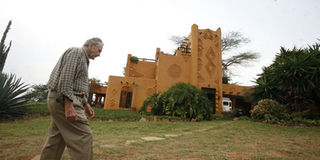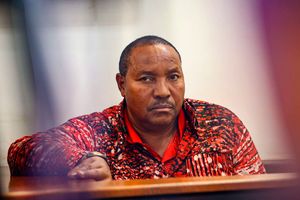Premium
Saving African Heritage House

Alan Donovan walks towards his African Heritage House in Mlolongo on February 13, 2014. The proposed railway line is supposed to pass where the Heritage House is. PHOTO/EVANS HABIL
What you need to know:
- Alan Donovan co-founded African Heritage Pan African Gallery with Joseph Murumbi, Kenya’s first foreign minister and second Vice-President.
- It is said that together with Murumbi and his wife, Sheila, they secured the largest private collection of African artefacts in Africa.
- African Heritage House acts as a mini-museum for cultural artefacts and Donovan is fighting to keep it from being knocked down
The saga that swirls around the fate of African Heritage House has been a magnet for sensationalism in recent months. We took a moment with the man of African Heritage House himself, Alan Donovan, to dispel the hearsay and get the real story.
Alan Donovan co-founded African Heritage Pan African Gallery with Joseph Murumbi, Kenya’s first foreign minister and second Vice-President. It is said that together with Murumbi and his wife, Sheila, they secured the largest private collection of African artefacts in Africa. African Heritage House acts as a mini-museum for cultural artefacts and Donovan is fighting to keep it from being knocked down.
Q: The last time we spoke, the China Road and Bridge Company (CRBC) under the authority of the Kenya Railways (KR) delivered the upsetting news that the house was to be demolished to make way for the new standard gauge high-speed railway. What happened after that?
Allan Donovan: Well, the Nairobi National Park Borderlands Residents Association, which is the neighbourhood association for the families who have resided along the rim of the Nairobi National Park for over 60 years, met with the engineers and officials of CRBC and they told us that there were three possible routes for the railway to pass along or through the park in this area.
Option one was on the present railway reserve, bordering the original steam train railway line constructed in 1898. This forms the border for the Nairobi National Park.
The second option was through the borderlands of the park, which causes maximum destruction of the properties along the park. The third was a route skirting the Mombasa Road and going back down to the Nairobi National Park. We will meet with the head engineer, who will make the final decision.
Why can’t new railway use the old route?
The main problem, as I understand it, is that when they built the 1898 route they did not have blasting materials and so the railway meanders around outcrops of granite. It is too crooked for a 21st century train to run on. They need to straighten the line.
Pretend you are Kenya Railways for a moment, what would you do?
The train could be put on a viaduct so animals have access to come and go under it. Passengers can enjoy the view.
There would be no need for fences along the railway. If the borderland residents are forced to move, it would be an environmental disaster for the park as they have been a bulwark to protect it. It would bring squatters, unplanned structures, sewage, noise and poaching right up to the border of the park.
The house was supposed be gazetted as a national monument through the assistance of the National Museums of Kenya. What happened with that?
I believe a proposal to that effect has been given to the Cabinet Secretary for Sports, the Arts, and Culture.
Who is Chap Kusimba and how is he involved in saving the house?
Chap Kusimba is a Kenyan-born anthropologist who has worked with American museums and universities for decades.
He recently moved from the Field Museum in Chicago to the American University in Washington DC, where he is head of the anthropology department and heads the university’s programmes in Africa.
The American University has a branch office in Nairobi and has a special programme for students in African Studies. It is my intention to make the African Heritage House an African Studies Centre and link it to the Murumbi collections in the Kenya National Archives and the National Museums.
I plan to set up a trust in perpetuity for the people of Kenya so they can continue to enjoy the house as a permanent museum and African Studies Centre. Universities like the American University and Strathmore University would be the main stakeholders in the African Heritage House.
The house would be linked to the National Museums and the National Archives through a Board of Trustees.
What do you think Murumbi would think of this plan?
This would be an appropriate tribute to Joseph and Sheila Murumbi. Murumbi sold his house in Muthaiga to the government of Kenya in 1977 on condition that it be made an African Studies Centre.
But his house was allowed to deteriorate until it was torn down and the collections moved to the basement of the present National Archives building where they were not properly displayed until 2006.
His house in Maasailand suffered a similar fate. It was transformed into a Maasai Research Centre but it now stands deserted and desecrated, its beautiful carved doors and windows taken away like what happened at his house in Muthaiga.
You have a large collection of African artefacts but do you think you add value to the visual arts in Kenya?
We are planning a major exhibition in the USA for the pioneer artists of East Africa who started their careers in art against all odds during the time of independence for African countries.
These artists will be given the international recognition they deserve. This touring exhibition is being organised by Chap Kusimba and his colleagues at American University which, by the way, has one of the largest exhibition spaces in America.
What were some of the other responses from affiliates or friends of the arts locally and internationally? Did anyone else offer support?
There has been a tremendous outpouring of support both locally and from museums and galleries worldwide.
Tell us about the petition.
The main petitions were started by a former dancer at African Heritage, Fernando Anuang’o, who now has a theatre in Paris, and the African Heritage and Art club at Strathmore University, many of whom were participants in a course I taught at the Murumbi African Heritage Collections for guides through the exhibits.
Then a former head model of African Heritage and Face of Africa winner, Emma Too, took up the cause, and others like media presenter Terri Chebet and former employees of African Heritage in Kenya and abroad have helped to push along the idea of circulating petitions in Uganda, Kenya, Paris, US and elsewhere. It is now on Google News Network.
There were rumours of the possibility of a new Murumbi museum, is there any truth to that?
I believe there is a plan to fund a new National Art Gallery by the Chinese, but that is only a dream at the moment.
You know Murumbi tried to get the government to put up a National Art Gallery in the Old PCs Office and to connect it to a larger gallery in Uhuru Park but Parliament did not think it was a priority then.
He also set up the Kenya National Archives when he was Vice-President.
A portion of the African Heritage – Murumbi Collection — is now at Nairobi Gallery. What has the response to this been?
The response from those who have visited this permanent exhibition has been phenomenal. We hope to increase the attendance through working with all the city centre hotels who have agreed to send visitors and this will happen after the new coffee shop opens for Point Zero coffee.
Why is the Murumbi legacy so important to you and to the world?
Not many people know about Murumbi and how he gave up his political career so near to the pinnacle of power because of what he viewed as the two main obstacles to the Kenya he wanted: corruption and tribalism.
He walked out of the government and chose to take another path which was to preserve, protect and promote African heritage.
That is why we set up the company of that name in Nairobi. I am working on his autobiography at the present time from transcripts he made that were found in Nairobi and in London, and this will enlighten people about all the work he has done for this country, Africa and the world.




